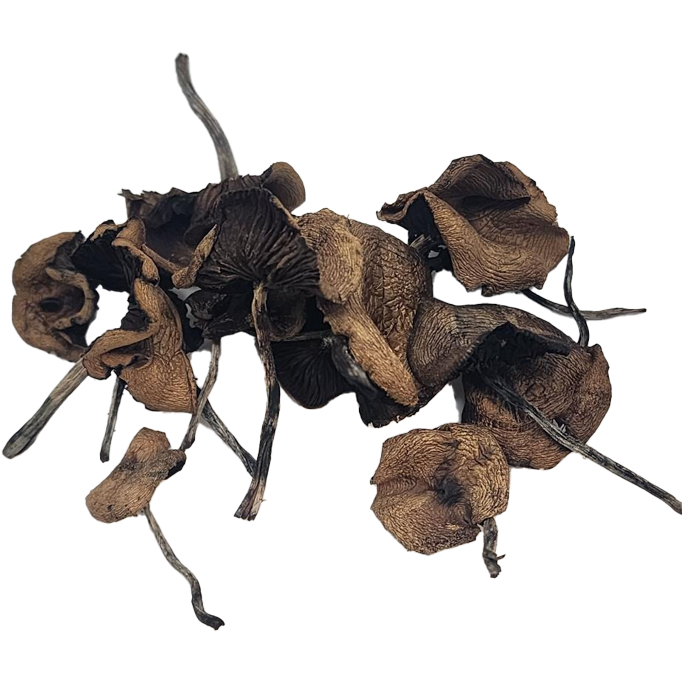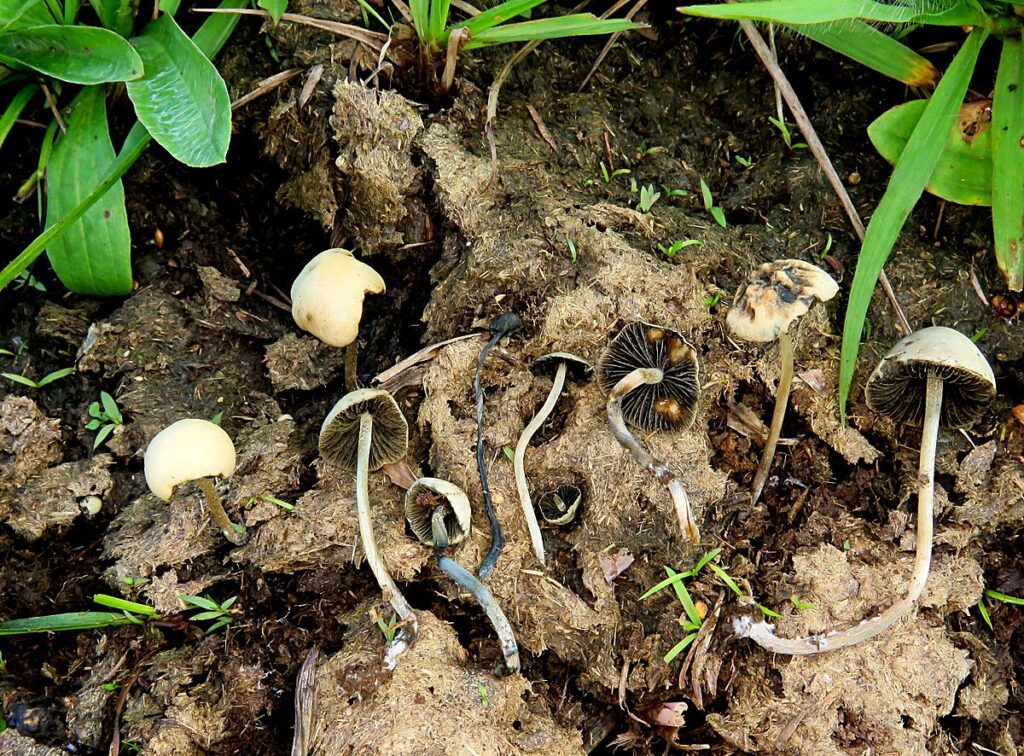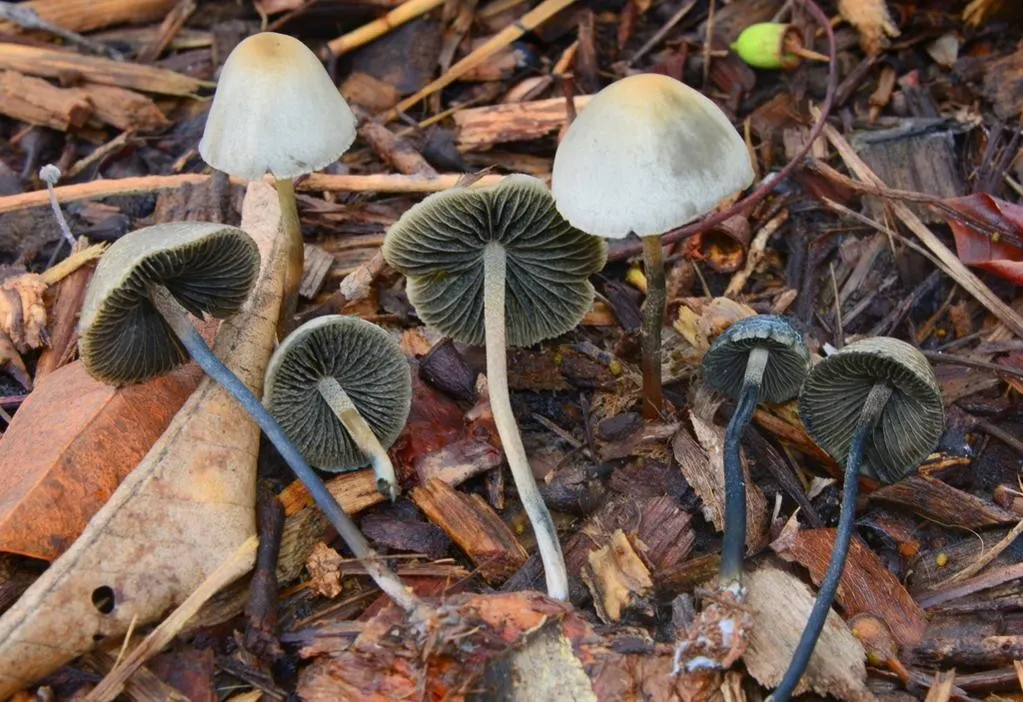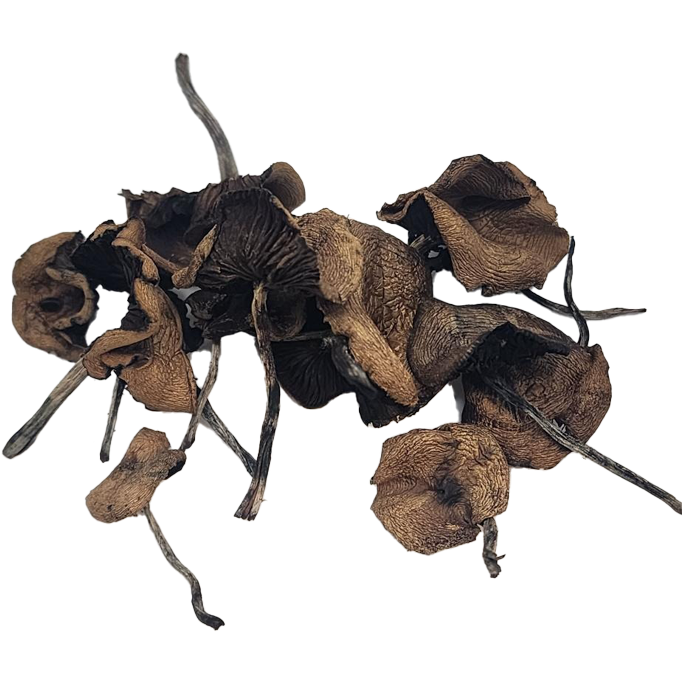
Panaeolus cyanescens, is one of the more potent species of psilocybin-containing mushrooms. They’re relatively small and easily go unnoticed by psychedelic mushroom foragers.
This species is the strongest member of the Panaeolus genus but delivers comparable potency to the average Psilocybe cubensis mushroom. Panaeolus cyanescens contains around 0.7% psilocybin and 0.1% psilocin.
Psilocybin is the prodrug for psilocin. Once inside the body, psilocybin is metabolized into the active form, psilocin. Mushrooms like Panaeolus cubensis, which contain high levels of psilocybin, tend to take longer to kick in than mushrooms like Psilocybe cyanescens, which has a much higher psilocin ratio.
Paneulus cyanescens is one of the stronger psilocybin-containing mushrooms out there, despite its relatively unassuming nature. In fact, this species is the strongest psychedelic member of the greater Panaeolus genus.
The mushrooms produced by this species are generally very small and have light gray-colored caps.
Panaeolus mushrooms — often called “mottlegills” due to the patches of color on the gills — are extremely common, but not all species of the genus contain psilocybin. They grow across the globe in several different countries, thrive in various climates, from tropical to temperate, and are capable of fruiting year-round.

The cyanescens species of the Panaeolus genus can be found growing in grassland, heathland, and open pastures. There are around 13 other species of Panaeolus that produce psilocybin, with P. cyanescens being the most common overall.
This Panaeolus species is a bit of a “freak of nature.” Unlike other psychedelic mushroom genera, such as Psilocybe, Panaeolus species don’t normally produce psilocybin or psilocin. It’s believed that Panaeolus cyanescens started producing these tryptamines through bacterial gene transfer from nearby Psilocybe mushrooms. Both Panaeolus cyanescens and many Psilocybe species thrive in the same environments (grasslands and pastures).
This mushroom isn’t popular with home growers because it produces a much lower yield than Psilocybe cubensis and tends to be pickier in terms of growing conditions. This mushroom is better for the wild forager than the DIY cultivator.
The best place to find this mushroom is in manure left behind by grazing animals. They can be hard to spot, but once you’ve found a patch, it’s a jackpot because they tend to pop up in dense clusters containing several hundred mushrooms.
The Potency & Effects of Pan Cyan
Panaeolus cyanescens is a notoriously potent species of psychedelic mushroom — don’t be fooled by its small stature.
Many people claim that this species’ shrooms contain two to three times the amount of psilocybin than the average Psilocybe cubensis strain — though this may not be entirely correct.
In the early 1960s, Albert Hofmann — famous for being the first person to synthesize LSD (lysergic acid diethylamide) — analyzed this species, then known as Copelandia cyanescens . Hofmann himself reported that these mushrooms contain far larger quantities of psilocin than psilocybin.
Psilocin is bioactive in humans, whereas psilocybin is not. The body must metabolize the psilocybin and turn it into psilocin — this is why the effects can take some time to kick in, and the peak of the psychedelic trip is “delayed.”
With higher levels of psilocin than psilocybin, fresh Panaeolus cyanescens have a faster onset of effects and a more sudden come-up.
Most studies involving this mushroom suggest its potency varies significantly. For example, a 1992 study by T. Stijve found Panaeolus cyanescens’ potency to be highly variable . Stijve discovered that the average potency fell between 0.17 to 0.95% psilocin and 0.16 to 0.19% psilocybin (dry weight).
Although P. cubensis may produce similar psilocybin levels, the species doesn’t seem capable of producing as much psilocin. This is likely why much stronger effects are reported from Panaeolus cyanescens than from Psilocybe cubensis.

EFFECTS OF PAN CYAN
Historical reports about the mind-altering and expanding effects of psilocybin are described as a visit to the spiritual world. While the hallucinogenic effects are comparable to LSD, psilocybin is 200 times less powerful, and the trip is significantly shorter.
Typical bodily reactions include enlarged pupils, relaxed muscles, and a cold feeling in the limbs and abdomen. Stronger doses of magic mushrooms lead to “bent” time and space, visionary deep thoughts (total understanding of “how the whole universe works”), greatly increased creativity, and, of course, hallucinations.
Psychonauts with prior psilocybin experience are often more prone to the effects and more easily “disconnect” from the daily reality—and cope much better with the newly acquired state of consciousness. To where this trip takes someone greatly depends on the traveller and their mood and state of mind. So your experience will (always!) be 100% unique. No matter how many stories you’ll hear or read about a trip, none will describe your personal visit to the “other, visionary world”.
Pan cyanescens is much stronger than any cubensis mushroom variety, and induces a more visual trip with vivid and “tropical” colours. The effects of a medium dose last for about 4–6 hours and then wear off gradually before disappearing completely.
Other effects include:
•Strong and vivid visual hallucinations
•Euphoria
•Lucidity
•Positive headspace
•Shifts in perspective of reality
•Changed sense of body and ego
HOW TO DOSE PAN CYAN

There are several schools of thought when it comes to dosing Pan Cyan, and it boils down to what you’re looking to get out of the experience. Of course, when it comes to your first time taking mushrooms, it’s advisable to proceed with caution. Taking a smaller dose allows users to establish a feel for the psychoactive nature of the mushroom. As a rule of thumb, it’s best to take your mushrooms on an empty stomach, as this allows for quicker absorption and more pronounced effects.
With that in mind, a typical small dose of Pan Cyan is around 2.1 grams of fresh mushrooms, or about 0.2 grams dried. A large dose would be about 7.7 grams fresh, or 0.8 grams dried. The mushrooms don’t have to be eaten as they are; they can also be added to hot water to create a tea, or you can mix them with hot chocolate or orange juice to mask the flavour.






